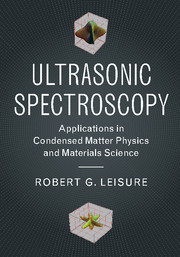Book contents
- Frontmatter
- Contents
- Preface
- 1 Introduction
- 2 Elasticity
- 3 Acoustic Waves in Solids
- 4 Experimental Methods
- 5 Elastic Constants
- 6 Ultrasonic Loss
- Appendix A Phase Shifts Due to Transducers and Bonds
- Appendix B Diffraction
- Appendix C Transducer Effects on Resonant Frequencies
- Appendix D Damped, Driven Oscillator and Complex Force Constant
- Appendix E Comparison of the Quasistatic and Experimental Temperature Dependence for Specific Cases
- References
- Index
Appendix E - Comparison of the Quasistatic and Experimental Temperature Dependence for Specific Cases
Published online by Cambridge University Press: 19 June 2017
- Frontmatter
- Contents
- Preface
- 1 Introduction
- 2 Elasticity
- 3 Acoustic Waves in Solids
- 4 Experimental Methods
- 5 Elastic Constants
- 6 Ultrasonic Loss
- Appendix A Phase Shifts Due to Transducers and Bonds
- Appendix B Diffraction
- Appendix C Transducer Effects on Resonant Frequencies
- Appendix D Damped, Driven Oscillator and Complex Force Constant
- Appendix E Comparison of the Quasistatic and Experimental Temperature Dependence for Specific Cases
- References
- Index
Summary
In this Appendix the quasistatic approximation will be tested by applying Equations 5.72 to two specific cases: silver and diamond. For these examples the. values, i.e., initial values, will be taken to be the experimental 0 K results. The expansion due to the zero point motion is included in these parameters.
Silver
Table E.1 gives the third-order elastic constants for silver and also diamond, which will be discussed in the follwing example. For Ag, the experimental second-order elastic constants are found in Refs. [242] and [27]. Also needed to carry out the calculations is, the fractional change in length due to thermal expansion [243]. (The inset figure on p. 299 of Ref. [243] has an error. The 10−6 on the vertical axis should be instead 10−5). Figure E.1 is based on the data of Ref. [243].
The third-order elastic constants, the 0 K second-order elastic constants, and the fractional change in length due to thermal expansion will now be used in Equations 5.72 to calculate the temperature-dependent, second-order elastic constants of Ag. The calculated results for c11 are shown in Figure E.2 along with the experimental results.
Figure E.3 shows similar results for c12 and c44. Figures E.2 and E.3 show exceptionally close agreement between the experimental values and those calculated based on thermal expansion and third-order elastic for all three independent elastic constants for silver. Error bars resulting from errors in the measurements of the third-order elastic constants were calculated for Figures E.2 and E.3. These are barely visible in the figures. The calculated and experimental results are in good agreement, and provide strong support for the quasistatic approximation, at least for silver.
Diamond
As a second example, a very different material is considered: single-crystal diamond. The third-order elastic constants [245], the thermal expansion [246], and the temperature-dependent second-order elastic constants have all been measured [151]. Figure E.4 shows the fractional change in length for diamond over the temperature range of 0–300 K. The data for this graph were obtained by a numerical integration of figure 5 of Ref. [246]. Comparison of Figures E.1 and E.4 show that diamond has a much smaller change in length than silver, and the temperature dependence is quite different.
- Type
- Chapter
- Information
- Ultrasonic SpectroscopyApplications in Condensed Matter Physics and Materials Science, pp. 222 - 226Publisher: Cambridge University PressPrint publication year: 2017



